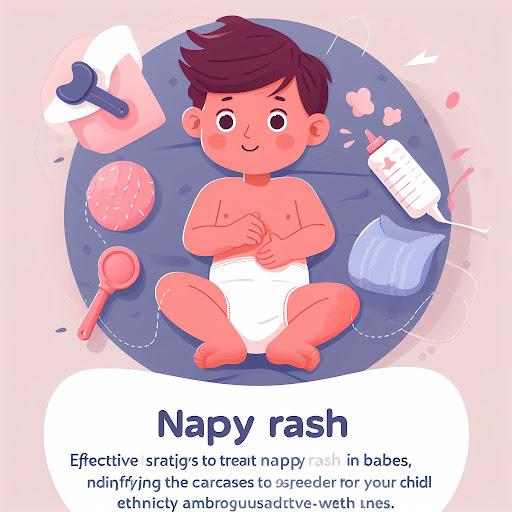Let’s address one common concern for parents of infants. These discomfiting and oftentimes hurting spots can cause distress for both the baby and caregiver. It’s necessary to know how to treat nappy rash in babies to be able to provide relief and ensure their well-being. This material was created to explore effective strategies for solving the issue quickly, providing valuable insights for parents and caregivers. Read more on the website https://littlebutterflylondon.com/.
Identifying the Problem of Nappy Rash Spots
To effectively address this problem, it’s important to first identify the tell-tale signs and understand what factors contribute to its development. Nappy rash, also known as diaper dermatitis, is characterized by red and irritated skin in the diaper area. The affected skin may appear chapped, inflamed, and sometimes there might be small raised bumps present. Recognizing these nappy rash spots is crucial for taking appropriate action.
Understanding the Causes
This common trouble of parents with infants can be distressing for both the little one and the caregiver. To effectively address this problem, it’s critical to understand what causes the problem.
One of the main causes of the above-mentioned condition is when a diaper remains wet for a prolonged time without being changed. The moisture softens the skin and increases its vulnerability to irritation.
One of the contributing factors is a lack of proper hygiene. Not changing diapers frequently enough and not properly cleaning the diaper area can increase the risk of developing this condition. It is important to keep the diaper area clean and dry in order to prevent and treat this condition.
A child’s diet can sometimes contribute to the development of diaper rash. For instance, introducing acidic foods or making changes to the little one’s diet can lead to changes in stool composition, which may cause skin irritation.
The little one’s skin can be irritated by contact with substances like certain chemicals found in baby wipes, soaps, or detergents. This irritation can contribute to the development of the problem.
The constant rubbing between the diaper and a little one’s sensitive skin may lead to the formation of a rash. When diapers are too tight or rough, it can worsen this friction.
Some babies may have a higher sensitivity to specific diaper materials, creams, or wipes. This sensitivity can cause skin irritation and the occurrence of diaper rash.

Tips and Techniques on How to Treat Nappy Rash in Babies
To effectively treat nappy rash in babies, a comprehensive approach is necessary. This includes practicing good hygiene, selecting appropriate products, and timely intervention. Here are some steps to follow for effective treatment:
- To prevent and treat diaper rash in babies, you can apply a protective barrier cream like zinc oxide or petroleum jelly. These creams create a shield that protects against moisture and friction.
- A crucial aspect of treating diaper rash is ensuring good hygiene. Make sure to change your child’s diaper frequently to minimize prolonged exposure to moisture and irritants. This straightforward measure can significantly lower the risk of developing diaper rash.
- It is recommended to choose breathable disposable diapers or cloth diapers that allow for better air circulation. Additionally, ensure that the diaper fits properly, neither too tight nor too loose, in order to minimize friction.
- After cleaning, it is important to thoroughly dry the area before putting on a new diaper. Gently pat the skin with a soft cloth, avoiding any rubbing that could potentially worsen irritation.
- When it comes to diaper changes, opt for warm water or and mild fragrance-free wipes with a soft cloth to clean your little one’s diaper area. Avoid using harsh soaps or scented wipes, as they can worsen the situation.
- Be cautious of potential irritants like soaps, wipes, or detergents that can be a cause of discomfort. Opt for products specifically formulated for sensitive baby skin to minimize the chances of developing the problem.
- If the diaper rash is severe, persistent, or accompanied by blisters, pus, or a fever, it is important to consult with a pediatrician. These symptoms may indicate a secondary infection that needs medical attention.
- Giving your child some time without a diaper can have benefits. Letting them lie on a clean and soft surface without a nappy allows their skin to breathe and heal.
- If the situation does not improve with the measures mentioned above, a pediatrician may suggest using a low-strength hydrocortisone cream to reduce inflammation. It’s important to use this cream only under the guidance of a healthcare professional.
Speedy Solutions – How to Treat Nappy Rash Quickly
To keep your child comfortable and minimize diaper changes, you might want to try using high-quality diapers that are super absorbent. These diapers can keep your little one dry for longer periods of time, reducing the need for frequent changes and minimizing moisture contact. Additionally, giving your baby oatmeal baths can provide soothing relief and promote healing. Simply add colloidal oatmeal to their bathwater for added comfort.
After cleaning your little one’s bottom, give the skin a few minutes to air dry. This simple step can help barrier creams work better. Avoid Tight Diapers: Make sure the diaper isn’t too tight; it should fit comfortably. Tight diapers can rub against the skin and make diaper rash worse.
If your child’s diaper rash does not show improvement within a day or two of home remedies, it is advisable to reach out to a pediatrician for professional guidance. Taking early action can help prevent the condition from worsening.
To effectively treat this condition, it’s important for parents to understand how to address the issue promptly and provide proper care. By recognizing the signs of the problem and utilizing appropriate treatment methods, parents can ensure their baby’s comfort and well-being. Maintaining good hygiene practices, using suitable products, and seeking guidance from a healthcare professional when needed are crucial steps in achieving a quick and effective resolution of nappy rash. It’s essential to remember that each kid is unique, so adapting these strategies to meet your little one’s individual needs is key.










![Is Tokyo Ghoul on Netflix? [How to Watch Online]](https://avctv.com/wp-content/uploads/2022/08/AAAABct1DaUzhEt4JeJFeDrmaE_4CGAu39fBN6poMx10hAlWlMRjkkAw84hjmuujWTy2wFC7_Pjnujec-_PqT1GCnnMFMJ15S04baJn1b0WvvbG6hrSNb31_GS4--120x86.jpg)





